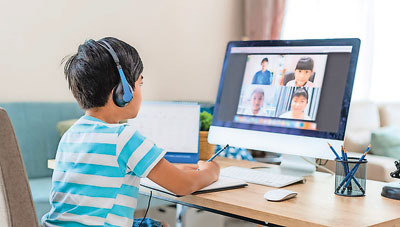Ushering ‘learning to students’ instead of ‘students to learning’
View(s): The corona virus pandemic has brought challenges to our educational structure as traditional classroom lessons have become difficult because of regular lockdowns. Even otherwise the 1-metre social distancing of students in the classrooms of most of our schools cannot be done effectively.
The corona virus pandemic has brought challenges to our educational structure as traditional classroom lessons have become difficult because of regular lockdowns. Even otherwise the 1-metre social distancing of students in the classrooms of most of our schools cannot be done effectively.
Proper washing of hands at the start of the school day too causes problems due to a large number of people congregating in a specified area with a limited number of washing facilities. Universities and some schools in major cities have introduced online classes to enable continuity of instruction and interaction.
The results of a survey have indicated that about 90% of the higher education institutes have carried out remote learning during the first phase of the pandemic in our country. The success may be due to the provision of free internet access to university servers by the Sri Lankan internet service providers.
The ‘new-normal’ in the field of education seem to be an expanded use of online learning tools. However, online learning too has its positives and negatives. An understanding of some of the advantages and disadvantages will help us find tools appropriate to our needs in the country and to take the required steps to be better prepared to adopt new opportunities and face the challenges that are created. Let us concentrate on some of the advantages first.
 Flexibility of location
Flexibility of location
Online learning allows students attend classes from a location of their choice. There is no restriction of geographical boundaries. This also brings in a lot of other conveniences such as not having to think about the dress and appearance and also, not having to worry about transport and food. This allows a lot of freedom to physically challenged students with the participation of lessons. The learners have a certain degree of anonymity and therefore the focus of attention can solely be on the learning content.
Flexibility of time
The lessons can be followed without having to worry about getting to school on time and the time pressures that are created due to traffic situations and transport providers. Therefore, increased attendance at lessons can be expected. Time can be saved to do more constructive work. Online lessons can be recorded and the accessibility for learning material is enhanced. Lessons can be followed even if a lesson is missed due to health or other reasons. The flexibility is there for a student to manage his or her own pace according to his/her capabilities and requirements.
Personal interaction
Group discussion is possible in online platforms. Some students are reluctant to contribute freely in a group environment of a normal classroom situation where all eyes maybe focused on that student. In an online situation, the freedom to state what you feel is felt more. In most online platforms, the facility is there to make oral or written comments. Students can control their own learning experience and adapt the discussions to meet their specific needs.
Resource accessibility
In an online setting it is easy to obtain the resources that are required to make the lesson complete, interesting and thought provoking. Research material relevant to the topic can be given to the students to enhance their knowledge of the topic. Further, guest presenters can be invited for an in-depth analysis of the topic under discussion. Videos too can be incorporated into the lessons as appropriate.
Let us now consider the major disadvantages.
Accessibility issues
Non availability of computers and/or internet facilities is a major problem that we face in Sri Lanka. This is mostly visible in rural areas due to economic reasons. In a good number of households there may be only one device available for use by all family members and therefore individuals may not be able to use it at the needed time. There are also consistent connectivity issues due to unstable electricity supply and frequent power interruptions.
Health hazards
The increased screen viewing time is a major concern with online learning and is a significant disadvantage. For some students focusing on the screen for an extended period- of- time can be challenging and distracting. It is important, therefore, to have regular breaks incorporated whenever online classes are organized.
Isolation issues
Physical interaction is non-existent with online lessons. It is important for youngsters to be in the company of their peers and it is a major contributory factor of their growth. In this situation students may tend to feel that they are been isolated. Taking this into consideration, it is paramount for schools not to limit online learning to academic lessons only.
Computer literacy issues
For the effective implementation of online education, both students and teachers need to have a reasonable level of computer knowledge. The teachers should be able to plan the sessions well to create a supportive environment in the virtual classroom. The curriculum needs to be developed to fall in line with the requirements of online learning. Educational authorities should consider investing in teacher training modules to get the best out of online lessons.
Some international schools have conducted selected extra-curricular activities, staff meetings, student assemblies and even parent-teacher conferences online with a high degree of success, in addition to academic lessons. It is a powerful tool and if used with care, it can provide highly successful results. The author David Merrill asks “With the growing popularity in e-learning, it occurred to me that the e should mean more than electronic. If we are going to call it e-learning, shouldn’t it be effective, efficient, and engaging?”
It seems as if we may have to live with this pandemic at least for a few more months. However, education of our youth cannot be disrupted. Opening schools for face-to-face lessons may not be a viable option as the only source of learning. In a survey carried out in 2019, the number of internet users in the country stood at 34%. Hopefully, it has gone above that figure by now.
However, 79% of rural houses had television sets. It is heartening to note that several television channels are now broadcasting lessons in different subjects.
The drawback is that it is not possible for students to have instant feedback for their queries, with these broadcasts. If the broadcasting of lessons can be coordinated, publicized and well-structured, it may enhance the number of beneficiaries. Perhaps the best option for Sri Lankan schools in rural areas is a combination of online classes, television broadcast lessons and face-to-face learning in classrooms adhering to health guidelines organized on a staggered basis.
However, it needs to be synchronized properly for its smooth continuity according to the needs of each school.
R.N.A. de Silva
ndesilva@osc.lk
The writer has over 40 years-experience in the field of education and is presently a member of the faculty of the Overseas School of Colombo. He is a senior examiner of the International Baccalaureate Organization and a consultant of a Hong Kong based online platform.


